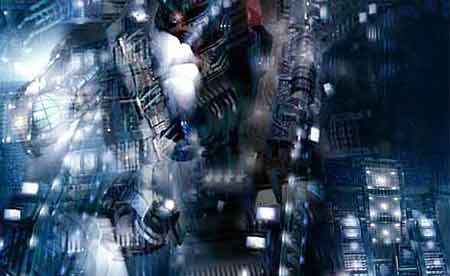BY LETTER
Post-scarcity
Culture and Society > Economics
Technology > Technology Type or Material > Nanotech
Culture and Society > Cultural Factors > Socio-Ecological Categories
Technology > Technology Type or Material > Nanotech
Culture and Society > Cultural Factors > Socio-Ecological Categories
Post-scarcity is an informal term used to describe societies and economies in which materials, energy, information, and skilled non-sophont labour are so superabundant and broadly distributed that all of the material needs and most of the ordinary material desires of ordinary sapient beings in them are readily available. Most societies and economies in the Civilized Galaxy and many of those elsewhere meet this standard; post-scarcity societies have been common in the Terragen Sphere since early First Federation times.
Supporting technologies for post-scarcity conditions include sentient-grade programs, neumann-capable machines, advanced nanotechnology, robotics, gengineering, and fusion or conversion reactors, as well as the prerequisite technologies for these such as sufficiently powerful and robust computational media, information storage, and information distribution networks. The low population densities relative to resources that are typical for most Terragens are also a factor, but not the deciding factor. Social and economic systems that make these advantages available to any member of a population without adverse side-effects have been widespread since the work of early First Federation memeticists, and are also prerequisite to any sustained post-scarcity condition.
Post-scarcity socioeconomics are considered the norm in the Terragen Sphere, but there are many exceptions, particularly outside the Sephirotics. These may be the result of local restrictions on technology, the disenfranchisement of some segments of a population, or other individual or community choices. In some cases, as in so-called Cinder Systems, they may be the result of explosive population growth in a restricted area if some or most of the persons present are unwilling or unable to leave. They may also be temporary results of war or disaster, or of dislocations and miscalculations in the early settlement of a new star system.
Prim or low-tech societies that have such abundant resources that the inhabitants are well satisfied and such low knowledge that they cannot imagine having something more are generally not considered true post-scarcity societies. Neither are virch bottle-worlds in which the desires of the inhabitants are similarly constrained. The usual conception of 'post-scarcity' is that limits are very broad, not that the limits are invisible to the individuals concerned.
Autotopias meet the definition of post-scarcity societies, but they have many other traits beyond superabundance of material goods. For instance, life in a post-scarcity economy or society is not necessarily secure or pleasant, or even particularly long; it is just that material goods are superabundant.
Related Articles
- Autotopia
- Digital Money
- Interstellar Econometrics
- Nivline
- Non-fungible Goods and Services in Post-scarcity Societies
- Post-scarcity Economies: Characteristics and Considerations
- Postcapitalism - Text by M. Alan Kazlev
Hyperturing-regulated high abundance nanotech economies which do not require money or other units of exchange. - Systems of Resource Allocation
- Wealth and Status in the Terragen Sphere
Appears in Topics
Development Notes
Text by Stephen Inniss
Initially published on 21 June 2012.
Initially published on 21 June 2012.







